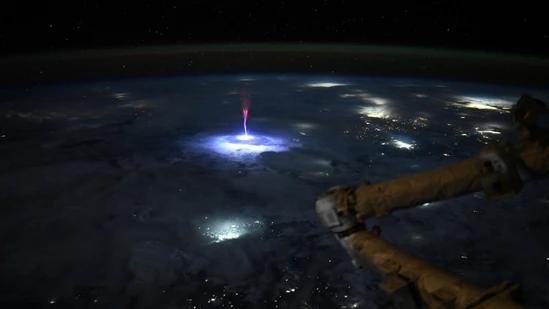
NASA Astronaut Captures Rare “Sprite” Lightning Over US & Mexico
On a rare and extraordinary occurrence, NASA astronaut Nichole Ayers captured a stunning image of a “sprite” lightning phenomenon while orbiting above the United States and Mexico from the International Space Station. The breathtaking picture showcases a brief burst of light that occurred above a thunderstorm, a phenomenon known as Transient Luminous Event (TLE).
Ayers, a NASA astronaut, shared the remarkable image on social media, captivating the attention of scientists and enthusiasts alike. The sprite, also known as a “red sprite,” is a type of TLE that appears as a bright, faintly glowing cloud above thunderstorms. These brief bursts of light are often difficult to capture, making Ayers’ photo a significant achievement.
According to NASA, sprites are electrical discharges that occur hundreds of kilometers above thunderstorms, typically above 50 km (31 miles) in altitude. They are relatively rare and are often invisible to the naked eye, making them a fascinating subject for scientists to study.
The sprite captured by Ayers is unlike any other, as it appears to be a bright, glowing cloud hovering above the clouds. The image is a testament to the incredible technological advancements made by NASA, allowing astronauts to capture such rare and extraordinary phenomena from space.
“This is a fantastic image that highlights the incredible work that NASA does to capture and study the Earth’s atmosphere,” said Dr. Richard Moore, a leading expert on TLEs. “Sprites are an important area of research for scientists, as they can provide valuable insights into the relationship between thunderstorms and the upper atmosphere.”
The sprite captured by Ayers is significant not only because of its rarity but also because it provides scientists with a unique opportunity to study the relationship between TLEs and thunderstorms. By analyzing images like Ayers’, scientists can gain a deeper understanding of the complex interactions between the upper atmosphere and thunderstorms.
“Scientists can use these types of photos to better understand the relationship of TLE to thunderstorms,” Ayers said. “By studying sprites, we can gain a better understanding of the electrical discharges that occur in the upper atmosphere and how they interact with thunderstorms.”
The capture of this rare “sprite” lightning phenomenon is a testament to the dedication and expertise of NASA’s astronauts and scientists. Their tireless efforts to study and understand the Earth’s atmosphere have led to numerous breakthroughs in our understanding of the complex interactions between the upper atmosphere and thunderstorms.
The image captured by Ayers is a reminder of the incredible beauty and complexity of the natural world. As scientists continue to study and learn more about TLEs like sprites, we can expect to uncover even more secrets about the Earth’s atmosphere and the incredible phenomena that occur within it.






